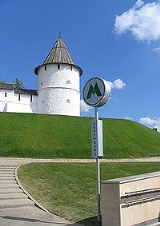
Kazan Metro
Encyclopedia
Kazan Metro is a rapid-transit system that serves the city of Kazan
, Republic of Tatarstan
, Russia
. Opened on August 27, 2005, it is the newest system in Russia, and the first one to open after the breakup of the Soviet Union
.
, but after the October Revolution
and the Russian Civil War
little was left for the design. Nevertheless, in the 1930s, Kazan, being the capital of the Tatar ASSR—one of the most visible autonomous republics and rapidly growing as an industrial centre—prompted some to propose a rapid transit system for the future, particularly after the successful construction of Moscow Metro
in 1935.
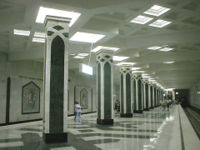 However, World War II
However, World War II
ended such attempts, and in the post-war USSR only the largest capitals of Union republics could afford a Metro system. Nevertheless, in 1979 the Kazan city's population passed the one million mark: a Soviet requirement for a Metro to be allowed. 1983 was the year when the Supreme Soviet of the Tatar ASSR authorised planning a metro system. The original design was to prove the final, as the City of Kazan effectively followed a typical Soviet model with a historical centre on the inflow of the Kazanka River
into the Volga, and the various industrial and "bedroom" districts (housing complexes) on the edges. The first line would follow a north-south axis beginning in the Transit Railway Station in the north, passing through the post-war Stalinist
buildings and then down south of the Kazanka, next to the Kazan Kremlin
and through the historical centre to the microdistrict
of Gorki.
The first geological surveillance began in 1984, and by 1989 the construction of the first stage was drawn up and submitted for final authorisation to begin construction. It was not to be. In 1991, the Soviet Union broke up and the economic, as well as political turmoil that rocked Tatarstan and Russia, caused the Kazan Metro project to be axed.
The first stage of six stations would feature deep level tunnels all built by tunnel boring machine
s and for the stations to be either sub-surface or elevated. Little of the original Soviet station plans was left in the architecture of the stations, with emphasis on traditional Tatar and Islamic motifs as well as modern high-tech designs. The first shield arrived in Kazan at the end of 1999 and was launched in May 2000.
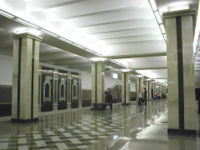 Initially, the pace was slow and the financial problems were about to prevent the construction to be completed on time. In a desperate attempt, in late 2003 the Russian Ministry of Transport ordered metro brigades from Samara and Moscow to assist and the first stage was made one station shorter, leaving the difficult path under the Kazanka River to open at latter time. Another contribution was made by the Almaty
Initially, the pace was slow and the financial problems were about to prevent the construction to be completed on time. In a desperate attempt, in late 2003 the Russian Ministry of Transport ordered metro brigades from Samara and Moscow to assist and the first stage was made one station shorter, leaving the difficult path under the Kazanka River to open at latter time. Another contribution was made by the Almaty
Metro construction brigade from Kazakhstan
. Thus, by the late 2004, a total of eight tunnel boring mechanisms were in operation. On the whole a total of thirteen individual tunnels had to be bored.
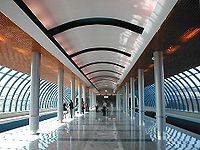 Despite a rocky start, Kazan Metro was triumphantly opened on August 27, 2005 by the President of Russia Vladimir Putin
Despite a rocky start, Kazan Metro was triumphantly opened on August 27, 2005 by the President of Russia Vladimir Putin
, President of Tatarstan Mintimer Shaymiyev, and the President of Kazakhstan Nursultan Nazarbayev
, as well as the mayor of Kazan and the heads of all existing Russian Metros.
The extension to Prospekt Pobedy
opened on December 29, 2008 as the first extension south of Gorki station in the second stage. On August 27, 2010 Metro will extend across the Kazanka River
, with the opening of the Zarechye (Metro) station.
Like all Metros in Russia and the former USSR, the station design exceeds all parameters and each station has its own architectural theme. At present two stations are single-vault, and two are pillar-spans. In addition, there is one station that exists on a combined glazed flyover.
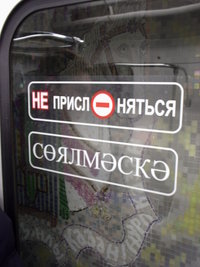 The metro runs from 6:00 to 23:00. The metro also sells "smart-tokens" valid for one day and "smart cards" (passes) which are valid for several trips or a specified length of time. There are discounted fares for pensioners, students, and children. Security is a major issue in the Kazan Metro, and is like all modern systems outfit with CCTV footage and each station has its own militsiya
The metro runs from 6:00 to 23:00. The metro also sells "smart-tokens" valid for one day and "smart cards" (passes) which are valid for several trips or a specified length of time. There are discounted fares for pensioners, students, and children. Security is a major issue in the Kazan Metro, and is like all modern systems outfit with CCTV footage and each station has its own militsiya
group for public order. Unlike major Metro systems in Russia, Kazan chose to maintain stricter rules that only resemble Saint Petersburg Metro
; for example, amateur photography is prohibited.
Although Russian is the only language on the technical level, the passenger service is fully bilingual with all signs and information being presented in both Russian
and Tatar
.
 The system uses the newest model 81-553.3/554.3 "Kazan" cars, produced by Saint Petersburg-based Vagonmash factory in cooperation with Škoda Dopravní Technika
The system uses the newest model 81-553.3/554.3 "Kazan" cars, produced by Saint Petersburg-based Vagonmash factory in cooperation with Škoda Dopravní Technika
of Plzeň, Czech Republic
. These are the most modern models currently in service in Russia and the former Soviet Union and they are fully automated. As a result, they do not require an engineer or a driver on board, just a supervisor. A total of twenty-four cars are currently in operation with a capacity of 250 people each. The rolling stock is maintained and repaired out of the new "Daurskoye" depot.
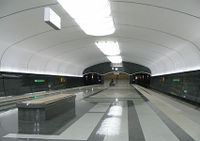
for construction has put KazMetroStroy, the daughter company that manages construction, in debt, and in payment of this debt one of the tunnel boring shields and its brigade is currently stationed in Samara to help complete a stretch there.
In Kazan itself, two extensions are being actively built. The southeastern one—Prospekt Pobedy
—was finished in August 2008, and the first station north of the Kazanka River
—Zarechye— is due to be completed in late 2009. The real hope is that by 2010 the line will reach the Transit Rail Terminal allowing the Metro to fully become the transport artery of the system.
In the more distant future, based on the current growth of the city, there are plans that by the 2030s the system will have up to five lines including a ring one based on the existing "electrichka" railway line.
Kazan
Kazan is the capital and largest city of the Republic of Tatarstan, Russia. With a population of 1,143,546 , it is the eighth most populous city in Russia. Kazan lies at the confluence of the Volga and Kazanka Rivers in European Russia. In April 2009, the Russian Patent Office granted Kazan the...
, Republic of Tatarstan
Tatarstan
The Republic of Tatarstan is a federal subject of Russia located in the Volga Federal District. Its capital is the city of Kazan, which is one of Russia's largest and most prosperous cities. The republic borders with Kirov, Ulyanovsk, Samara, and Orenburg Oblasts, and with the Mari El, Udmurt,...
, Russia
Russia
Russia or , officially known as both Russia and the Russian Federation , is a country in northern Eurasia. It is a federal semi-presidential republic, comprising 83 federal subjects...
. Opened on August 27, 2005, it is the newest system in Russia, and the first one to open after the breakup of the Soviet Union
Soviet Union
The Soviet Union , officially the Union of Soviet Socialist Republics , was a constitutionally socialist state that existed in Eurasia between 1922 and 1991....
.
Planning
Kazan is a historic and cultural centre on the middle Volga. The first plans to have a rapid-transit system were proposed back in the days of the Russian EmpireRussian Empire
The Russian Empire was a state that existed from 1721 until the Russian Revolution of 1917. It was the successor to the Tsardom of Russia and the predecessor of the Soviet Union...
, but after the October Revolution
October Revolution
The October Revolution , also known as the Great October Socialist Revolution , Red October, the October Uprising or the Bolshevik Revolution, was a political revolution and a part of the Russian Revolution of 1917...
and the Russian Civil War
Russian Civil War
The Russian Civil War was a multi-party war that occurred within the former Russian Empire after the Russian provisional government collapsed to the Soviets, under the domination of the Bolshevik party. Soviet forces first assumed power in Petrograd The Russian Civil War (1917–1923) was a...
little was left for the design. Nevertheless, in the 1930s, Kazan, being the capital of the Tatar ASSR—one of the most visible autonomous republics and rapidly growing as an industrial centre—prompted some to propose a rapid transit system for the future, particularly after the successful construction of Moscow Metro
Moscow Metro
The Moscow Metro is a rapid transit system serving Moscow and the neighbouring town of Krasnogorsk. Opened in 1935 with one line and 13 stations, it was the first underground railway system in the Soviet Union. As of 2011, the Moscow Metro has 182 stations and its route length is . The system is...
in 1935.

World War II
World War II, or the Second World War , was a global conflict lasting from 1939 to 1945, involving most of the world's nations—including all of the great powers—eventually forming two opposing military alliances: the Allies and the Axis...
ended such attempts, and in the post-war USSR only the largest capitals of Union republics could afford a Metro system. Nevertheless, in 1979 the Kazan city's population passed the one million mark: a Soviet requirement for a Metro to be allowed. 1983 was the year when the Supreme Soviet of the Tatar ASSR authorised planning a metro system. The original design was to prove the final, as the City of Kazan effectively followed a typical Soviet model with a historical centre on the inflow of the Kazanka River
Kazanka River
Kazanka or Qazansu is a river in the Republic of Tatarstan, Russia, a left tributary of the Volga. Kazanka begins near the village of Bimeri in Arsk District and flows into the Samara Reservoir in Kazan, near the Kazan Kremlin. Another towns on the Kazanka are Arsk and historical Iske Kazan. The...
into the Volga, and the various industrial and "bedroom" districts (housing complexes) on the edges. The first line would follow a north-south axis beginning in the Transit Railway Station in the north, passing through the post-war Stalinist
Stalinist architecture
Stalinist architecture , also referred to as Stalinist Gothic, or Socialist Classicism, is a term given to architecture of the Soviet Union between 1933, when Boris Iofan's draft for Palace of the Soviets was officially approved, and 1955, when Nikita Khrushchev condemned "excesses" of the past...
buildings and then down south of the Kazanka, next to the Kazan Kremlin
Kazan Kremlin
The Kazan Kremlin is the chief historic citadel of Tatarstan, situated in the city of Kazan. It was built on behest of Ivan the Terrible on the ruins of the former castle of Kazan khans...
and through the historical centre to the microdistrict
Microdistrict
Microdistrict, or microraion , is a residential complex—a primary structural element of the residential area construction in the Soviet Union and in some post-Soviet and former Communist states...
of Gorki.
The first geological surveillance began in 1984, and by 1989 the construction of the first stage was drawn up and submitted for final authorisation to begin construction. It was not to be. In 1991, the Soviet Union broke up and the economic, as well as political turmoil that rocked Tatarstan and Russia, caused the Kazan Metro project to be axed.
Construction
Luckily for Kazan, throughout the 1990s, the status of it being the most visible autonomous capital reinforced its position; enough for the Federal government to issue a review of the project in 1995 and authorising the construction. The most prominent deadline was the city's millennium anniversary in 2005. After securing financing and training, the first stone was laid on August 27, 1997 in a triumphal display eight years prior to beginning.The first stage of six stations would feature deep level tunnels all built by tunnel boring machine
Tunnel boring machine
A tunnel boring machine also known as a "mole", is a machine used to excavate tunnels with a circular cross section through a variety of soil and rock strata. They can bore through anything from hard rock to sand. Tunnel diameters can range from a metre to almost 16 metres to date...
s and for the stations to be either sub-surface or elevated. Little of the original Soviet station plans was left in the architecture of the stations, with emphasis on traditional Tatar and Islamic motifs as well as modern high-tech designs. The first shield arrived in Kazan at the end of 1999 and was launched in May 2000.

Almaty
Almaty , also known by its former names Verny and Alma-Ata , is the former capital of Kazakhstan and the nation's largest city, with a population of 1,348,500...
Metro construction brigade from Kazakhstan
Kazakhstan
Kazakhstan , officially the Republic of Kazakhstan, is a transcontinental country in Central Asia and Eastern Europe. Ranked as the ninth largest country in the world, it is also the world's largest landlocked country; its territory of is greater than Western Europe...
. Thus, by the late 2004, a total of eight tunnel boring mechanisms were in operation. On the whole a total of thirteen individual tunnels had to be bored.

Vladimir Putin
Vladimir Vladimirovich Putin served as the second President of the Russian Federation and is the current Prime Minister of Russia, as well as chairman of United Russia and Chairman of the Council of Ministers of the Union of Russia and Belarus. He became acting President on 31 December 1999, when...
, President of Tatarstan Mintimer Shaymiyev, and the President of Kazakhstan Nursultan Nazarbayev
Nursultan Nazarbayev
Nursultan Abishuly Nazarbayev has served as the President of Kazakhstan since the nation received its independence in 1991, after the fall of the Soviet Union...
, as well as the mayor of Kazan and the heads of all existing Russian Metros.
The extension to Prospekt Pobedy
Prospekt Pobedy (Kazan Metro)
Prospekt Pobedy or Ciñü Prospektı is a station of the Kazan Metro. The station was to be the first extension of the system three years since its opening in 2005 and was opened on 29 December 2008....
opened on December 29, 2008 as the first extension south of Gorki station in the second stage. On August 27, 2010 Metro will extend across the Kazanka River
Kazanka River
Kazanka or Qazansu is a river in the Republic of Tatarstan, Russia, a left tributary of the Volga. Kazanka begins near the village of Bimeri in Arsk District and flows into the Samara Reservoir in Kazan, near the Kazan Kremlin. Another towns on the Kazanka are Arsk and historical Iske Kazan. The...
, with the opening of the Zarechye (Metro) station.
Operation
At present, the Kazan Metro is a single-line system that stretches nearly ten kilometres and has seven stations. As the newest of all Russian systems, it is also the most modern of them. Smart-card ticketing and semi-automated train drive are features that at the time were just being introduced in selected Moscow stations, let alone in complete metro systems. It is operated by a municipality company MetroElektroTrans .Like all Metros in Russia and the former USSR, the station design exceeds all parameters and each station has its own architectural theme. At present two stations are single-vault, and two are pillar-spans. In addition, there is one station that exists on a combined glazed flyover.
Service

Militsiya
Militsiya or militia is used as an official name of the civilian police in several former communist states, despite its original military connotation...
group for public order. Unlike major Metro systems in Russia, Kazan chose to maintain stricter rules that only resemble Saint Petersburg Metro
Saint Petersburg Metro
The Saint Petersburg Metro is the underground railway system in Saint Petersburg and Leningrad Oblast, Russia. It has been open since November 15, 1955.Formerly known as the V.I...
; for example, amateur photography is prohibited.
Although Russian is the only language on the technical level, the passenger service is fully bilingual with all signs and information being presented in both Russian
Russian language
Russian is a Slavic language used primarily in Russia, Belarus, Uzbekistan, Kazakhstan, Tajikistan and Kyrgyzstan. It is an unofficial but widely spoken language in Ukraine, Moldova, Latvia, Turkmenistan and Estonia and, to a lesser extent, the other countries that were once constituent republics...
and Tatar
Tatar language
The Tatar language , or more specifically Kazan Tatar, is a Turkic language spoken by the Tatars of historical Kazan Khanate, including modern Tatarstan and Bashkiria...
.
Trainsets

Škoda Works
Škoda Works was the largest industrial enterprise in Austro-Hungary and later in Czechoslovakia, one of its successor states. It was also one of the largest industrial conglomerates in Europe in the 20th century...
of Plzeň, Czech Republic
Czech Republic
The Czech Republic is a landlocked country in Central Europe. The country is bordered by Poland to the northeast, Slovakia to the east, Austria to the south, and Germany to the west and northwest....
. These are the most modern models currently in service in Russia and the former Soviet Union and they are fully automated. As a result, they do not require an engineer or a driver on board, just a supervisor. A total of twenty-four cars are currently in operation with a capacity of 250 people each. The rolling stock is maintained and repaired out of the new "Daurskoye" depot.

Future
Since its opening in 2005, the Kazan Metro immediately cut travel time for affected commuters by over an hour. Nonetheless, there have been several problems with the system, including tunnel flooding and financial setbacks. Moreover, a partnership with Samara MetroSamara Metro
Samara Metro , formerly known as the Kuybyshev Metro , is a rapid transit system which serves the city of Samara, Russia. Opened in 1987, it consists of one line with 9 stations and 11.4 km of bi-directional long track.-History:...
for construction has put KazMetroStroy, the daughter company that manages construction, in debt, and in payment of this debt one of the tunnel boring shields and its brigade is currently stationed in Samara to help complete a stretch there.
In Kazan itself, two extensions are being actively built. The southeastern one—Prospekt Pobedy
Prospekt Pobedy (Kazan Metro)
Prospekt Pobedy or Ciñü Prospektı is a station of the Kazan Metro. The station was to be the first extension of the system three years since its opening in 2005 and was opened on 29 December 2008....
—was finished in August 2008, and the first station north of the Kazanka River
Kazanka River
Kazanka or Qazansu is a river in the Republic of Tatarstan, Russia, a left tributary of the Volga. Kazanka begins near the village of Bimeri in Arsk District and flows into the Samara Reservoir in Kazan, near the Kazan Kremlin. Another towns on the Kazanka are Arsk and historical Iske Kazan. The...
—Zarechye— is due to be completed in late 2009. The real hope is that by 2010 the line will reach the Transit Rail Terminal allowing the Metro to fully become the transport artery of the system.
In the more distant future, based on the current growth of the city, there are plans that by the 2030s the system will have up to five lines including a ring one based on the existing "electrichka" railway line.

